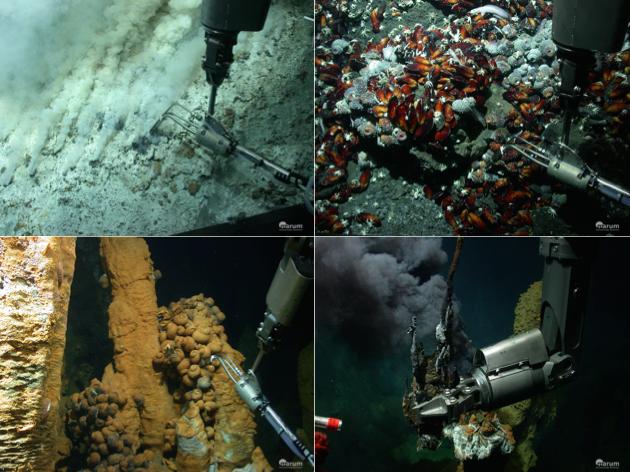Small-space niche formation at hydrothermal vents

Sampling sites. By dint of ROV Quest, Meier and his colleagues sampled fluids and water as well as different surfaces at hydrothermal vents in the Manus Basin. MARUM – Center for Marine Environmental Sciences, University of Bremen
Organisms inhabiting deep-sea hydrothermal vents face quite some challenges.
At such vents, water heated in the Earth’s interior exits the seafloor at temperatures of more than 300 degrees Celsius. These high temperatures become possible due to enormous pressure in the deep sea, which increases the boiling point of the water. Moreover, not the smallest sparkle of sunlight reaches these depths.
Thus, the conversion of carbon dioxide into biomass through photosynthesis, as done by plants, is impossible. Other sources of energy are required. Microorganisms in the deep sea therefore use chemical compounds such as methane or sulfide, which stream from the hot vents, to grow. This way, they form the basis of the local food chain.
In this extreme habitat, the living conditions for the local fauna change drastically at very small scales. After emergence, the hot vent water mixes with the surrounding, four degrees cold seawater and rapidly cools. The same applies to the content of, for example, sulfide: Just a few centimetres from the vent opening, concentrations diminish to only a fraction of their original magnitude.
How do the resident microorganisms manage to adapt to such a small-scale environment? Are there ecological niches, as we know them from other habitats? The biologist Dimitri Meier and colleagues from the Max Planck Institute for Marine Microbiology in Bremen, together with marine researchers from MARUM in Bremen and Harvard University in Cambridge, USA, are investigating these questions in a new publication in The ISME Journal.
Who lives where is clearly regulated
On a research cruise to hydrothermal vents in the Manus Basin off Papua New Guinea, the researchers collected gas and water samples as well as samples of different surfaces in the immediate vicinity of the vents. In the laboratory in Bremen, they then examined the microorganisms living there. The examination showed that “who lives where” at the hot vents is clearly defined.
“Hydrothermal vents around the world are mainly populated by two groups of bacteria”, explains Meier. “The so-called SUP05 gammaproteobacteria and epsilonproteobacteria of the genera Sulfurovum and Sulfurimonas. We found clear evidence that the widespread SUP05 bacteria are adapted to low sulfide concentrations. The epsilonproteobacteria, on the other hand, live much closer to the vent opening at much higher sulfide values.”
The epsilonproteobacteria have some special skills to live in this infernal high-energy habitat. “Our analyses of their genes revealed that they possess enhanced surface attachment and stress resistance mechanisms”, says Meier. “The SUP05 bacteria lack these capabilities and thus cannot hold themselves in turbulent and toxic mixing areas.”
New insights into species formation in microorganisms
The study also sheds a new light on species formation in microorganisms. The researchers found evidence that a bacterial group can diversify into many different genera and species if it is exposed to environmental conditions varying strongly at very small scales. The SUP05 bacteria occurring in constantly cold and meagre conditions were represented by few, very closely related species. Within the epsilonproteobacteria, on the other hand, there was a very high diversity of species. This diversity, however, does not mean that the different species also take on different functions in their habitat. The genetic make-up of the various species was comparable.
Yet, one thing stood out, the researchers report: Certain key genes encoding the sulfur oxidation were as diverse as the marker genes used for species identification. “Apparently, there are a lot of different types of epsilonproteobacteria that all oxidise sulfide and bind carbon dioxide, but have specialised on very specific conditions, such as different sulfide concentrations,” says Meier. “That is what we want to investigate next.”
Original publication
Dimitri V. Meier, Petra Pjevac, Wolfgang Bach, Stephane Hourdez, Peter R Girguis, Charles Vidoudez, Rudolf Amann and Anke Meyerdierks (2017): Niche partitioning of diverse sulfur-oxidizing bacteria at hydrothermal vents. ISME Journal.
doi:10.1038/ismej.2017.37
Link: https://www.nature.com/ismej/journal/vaop/ncurrent/pdf/ismej201737a.pdf
Please direct your queries to
Dr. Dimitri Meier
MPI für Marine Mikrobiologie
Telefon: +49 421 2028 942
dmeier@mpi-bremen.de
or the press office
Dr. Fanni Aspetsberger
Phone: +49 421 2028 947
Dr. Manfred Schlösser
Phone: +49 421 2028 704
E-Mail: presse@mpi-bremen.de
Media Contact
All latest news from the category: Life Sciences and Chemistry
Articles and reports from the Life Sciences and chemistry area deal with applied and basic research into modern biology, chemistry and human medicine.
Valuable information can be found on a range of life sciences fields including bacteriology, biochemistry, bionics, bioinformatics, biophysics, biotechnology, genetics, geobotany, human biology, marine biology, microbiology, molecular biology, cellular biology, zoology, bioinorganic chemistry, microchemistry and environmental chemistry.
Newest articles

Innovative vortex beam technology
…unleashes ultra-secure, high-capacity data transmission. Scientists have developed a breakthrough optical technology that could dramatically enhance the capacity and security of data transmission (Fig. 1). By utilizing a new type…

Tiny dancers: Scientists synchronise bacterial motion
Researchers at TU Delft have discovered that E. coli bacteria can synchronise their movements, creating order in seemingly random biological systems. By trapping individual bacteria in micro-engineered circular cavities and…

Primary investigation on ram-rotor detonation engine
Detonation is a supersonic combustion wave, characterized by a shock wave driven by the energy release from closely coupled chemical reactions. It is a typical form of pressure gain combustion,…



